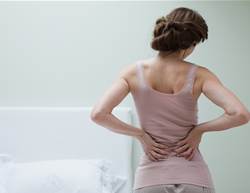Every person feels anxious from time to time. Waiting in a queue, sitting in traffic or awaiting test results can all push stress levels up. Beyond everyday worry, about one in five adults live with an anxiety disorder, making it the most common mental health condition. So how do you tell the difference between occasional nerves and anxiety that may need treatment? Knowing the physical symptoms is a smart place to start.
“When anxiety shows up, people may feel irritable, tired, restless and out of balance,” says psychiatrist Dr David Merrill. While these feelings are easy to link to anxiety, other symptoms can mimic a cold, flu, allergies or even a hangover—yet still be connected. According to Dr Merrill, mental and physical symptoms often feed each other in a loop. For example, anxiety can trigger digestive problems, and those effects can, in turn, worsen anxiety.
Below, mental health experts share the most common physical ways the body manifests anxiety, plus how to address these symptoms—and the anxiety behind them—so you can feel better fast.
Physical symptoms of anxiety
1. Rapid heart rate
Anxiety is part of the body’s built-in alarm system, alerting you to potential danger, says clinical psychologist Joseph Laino. When the amygdala senses a threat, it triggers a surge of stress hormones like cortisol and adrenaline. Your heart rate and blood pressure climb and you may feel palpitations. “That reaction is essential to our preservation because a surge of anxiety can propel us to move quickly,” Laino says. Problems arise when the alarm stays switched on, prolonging a response designed to be brief.
2. Chills or sweating
As part of the fight-or-flight response, the hypothalamus—which regulates body temperature—can swing you hot or cold, explains psychiatrist Dr Merrill. You might suddenly feel chilled, drenched in sweat or both. Muscles also prime for action during anxiety, which can add odd aches alongside those hot or cold flashes.
3. Shortness of breath
The heart and lungs work as a team, so a sudden rise in heart rate can prompt your lungs to power up as well, says Dr Merrill. “This is why, in extreme anxiety—like a panic attack—you’ll not only have a rapid heart rate but also shortness of breath, and the advice with those is to try and implement deep breathing so that both can get corrected,” he says. If you have chest pain, symptoms don’t settle, or they worsen after a few minutes, seek urgent medical care.
4. Nausea or indigestion
Anxiety also recruits the central nervous system. The gut contains more nerve fibres than anywhere else in the body, which is why excitement can bring on “butterflies,” Dr Merrill explains. Serotonin plays a role too. Most serotonin—the “happy chemical” that sends signals between nerve cells—lives in the gut, and emotional distress can disrupt nerve signalling and serotonin balance. The result can be nausea, indigestion and general stomach upset. “Any kind of emotional imbalance like anxiety is likely to create stomach issues,” says Dr Merrill.
5. Constipation or diarrhoea
When the body gears up for a threat, it redirects resources like blood flow to systems needed for short-term mobilisation. Digestion is not one of them. “As your blood flows toward muscles, vision and hearing to react to threats, your motility can change,” says Dr Merrill. That often slows the gut and leads to constipation, although some people swing the other way toward diarrhoea. You may even toggle between the two. Bloating, excess gas, abdominal pain and cramping can travel with these shifts.
6. Tingling, sharp pains, and tightness
Because the central nervous system links to the peripheral nervous system, anxiety in the brain can trigger signals throughout the body. Nerves “fire up” to keep you ready to act, just like the heart, lungs and muscles. “Because your nerves are activated, that can create an effect anywhere along those nerve systems,” says Dr Merrill. You might notice tingling in fingers or toes or hairs standing on end. Sudden nerve firing can also bring sharp pains or a feeling of tightness, especially where nerve bundles are dense such as the lower back, jaw or neck.
How to deal with your symptoms and ease your anxiety
Once you recognise the physical signs of anxiety, a few practical steps can help. Mindfulness-based practice can be useful, especially when it pairs breathwork with gentle movement. “Yoga or tai chi incorporate breathwork and movement in their practices,” says Dr Merrill, which can settle the nervous system while easing muscle tension.
For treatment, speak with your healthcare professional about your symptoms and whether anxiety could be a contributing cause. A proper assessment rules out other conditions and guides next steps. “Just because a symptom is linked to anxiety doesn’t mean it should be ignored,” says Laino. “There are various medicines and talk therapies that can help people who suffer with acute, chronic or post-traumatic anxieties.”
The upside: as anxiety loosens its grip, many of the physical symptoms often ease too.










